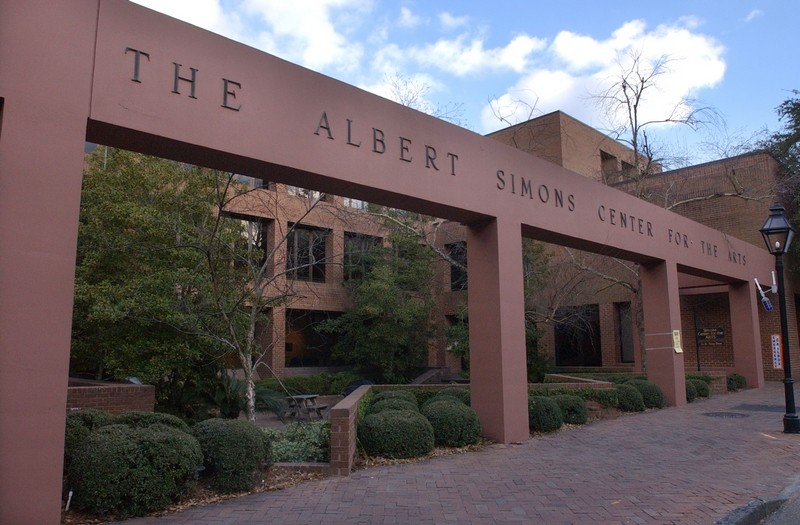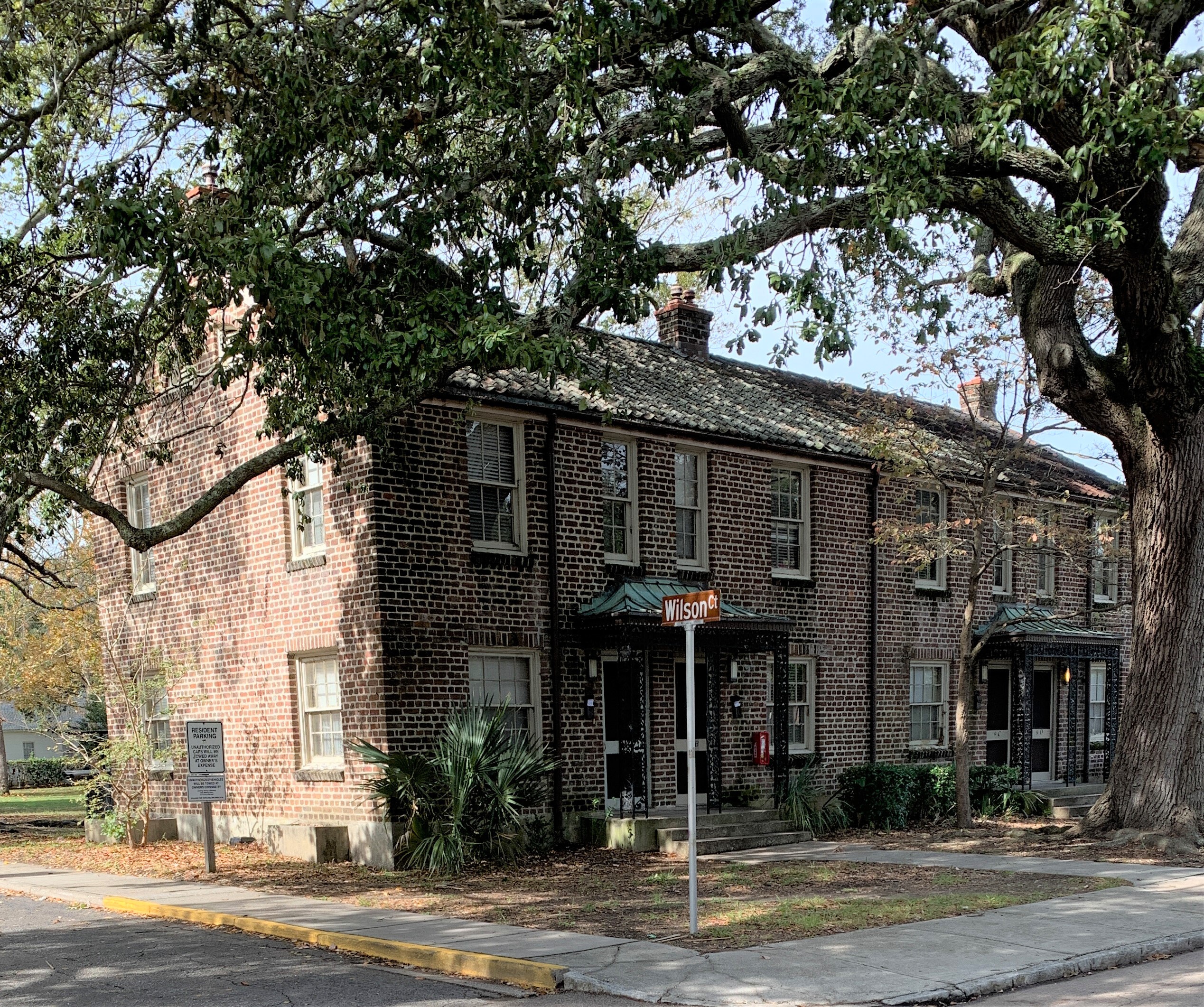|
Gadsden Green Homes
Gadsden Green Homes is a housing complex located in the Westside neighborhood in Charleston, South Carolina. The name comes from the neighborhood which had been owned by Christopher Gadsden. The housing project was built in two stages: the eastern half (bounded by Line St. to the north, President St. to the east, Bogard and Allway Sts. to the south, and Flood St. to the west) was constructed in 1942 while the western half (bounded by Line St. to the north, Flood St. to the east, Allway St. to the south, and Hagood Ave. to the west) was finished in 1968. Phase 1 Planning for a new housing project, specifically for Black residents, began in 1939. Built during the segregation era, the housing project was the fourth in Charleston specifically for Black residents. The project was expected to cost about $700,000 following plans developed by Charleston Rehousing Architects (a firm made up of Douglas Ellington, David Hyer, Albert Simons, and Samuel Lapham VI). A survey was undertake ... [...More Info...] [...Related Items...] OR: [Wikipedia] [Google] [Baidu] |
Charleston, South Carolina
Charleston is the List of municipalities in South Carolina, most populous city in the U.S. state of South Carolina. The city lies just south of the geographical midpoint of South Carolina's coastline on Charleston Harbor, an inlet of the Atlantic Ocean formed by the confluence of the Ashley River, Ashley, Cooper River (South Carolina), Cooper, and Wando River, Wando rivers. Charleston had a population of 150,227 at the 2020 United States census, 2020 census. The population of the Charleston metropolitan area, South Carolina, Charleston metropolitan area, comprising Berkeley County, South Carolina, Berkeley, Charleston County, South Carolina, Charleston, and Dorchester County, South Carolina, Dorchester counties, was estimated to be 849,417 in 2023. It ranks as the South Carolina statistical areas, third-most populous metropolitan area in the state and the Metropolitan statistical area, 71st-most populous in the U.S. It is the county seat of Charleston County, South Carolina, Ch ... [...More Info...] [...Related Items...] OR: [Wikipedia] [Google] [Baidu] |
Christopher Gadsden
Christopher Gadsden (February 16, 1724 – August 28, 1805) was an American politician who was the principal leader of the South Carolina Patriot movement during the American Revolution. He was a delegate to the Continental Congress, a brigadier general in the Continental Army during the American Revolutionary War, Lieutenant Governor of South Carolina, a merchant, and the designer of the Gadsden flag. He is a signatory to the Continental Association. Early life Gadsden was born in 1724 in Charleston, South Carolina. He was the son of Thomas Gadsden, who had been in the Royal Navy before becoming customs collector for the Port of Charleston. His grandfather, Edward Gadsden, was born in Wiltshire, England, in 1672 and emigrated to South Carolina in 1695. He was sent to school near Bristol, England. He returned to America in 1740 and served as an apprentice at a counting house in Philadelphia, Pennsylvania. He inherited a large fortune from his father who died in 1741. From 17 ... [...More Info...] [...Related Items...] OR: [Wikipedia] [Google] [Baidu] |
Douglas Ellington
Douglas Dobell Ellington (26 June 1886 – 27 August 1960) was an American architect who is noted for his work in the Art Deco style. Biography Ellington studied architecture at the Drexel Institute in Philadelphia, the University of Pennsylvania, and the École des Beaux-Arts in Paris. Ellington was the first American to win the Rougevin prize. After returning from France, he worked as a professor of architecture at Columbia University and then the Carnegie Institute of Technology. During World War I, Ellington worked with the United States Navy, supervising the design of camouflage for ships. Ellington subsequently returned to Pittsburgh where he opened a private architectural practice. In 1929, he designed the S&W Cafeteria location at 60 Patton Avenue in Asheville. While living in Asheville, he also designed notable buildings of the art deco era: Asheville City Hall, First Baptist Church of Asheville, and Asheville High School. During World War II, Ellington designed a ... [...More Info...] [...Related Items...] OR: [Wikipedia] [Google] [Baidu] |
David Hyer
David Burns Hyer (May 21, 1875 – December 11, 1942) was an American architect who practiced in Charleston, South Carolina and Orlando, Florida during the first half of the twentieth century, designing civic buildings in the Neoclassical Revival and Mediterranean Revival styles. Biography David Burns Hyer was born on May 21, 1875, in Charleston, South Carolina, the youngest son of James S. Hyer and Ella Payne. Hyer served as a civil engineer at the Charleston Navy Yard and for many Southern railways, before opening his own private architectural practice in Charleston. Hyer’s Charleston office was located in the People's Building. David Hyer married Sally Yeadon Mazyck, daughter of James Mazyck, in June 1904; they had four children: David B Hyer Jr., Yeadon Mazyck Hyer, Robert Payne Hyer and Helen Hyer Active in Charleston (see partial list of works below) Hyer was a member of the South Carolina Chapter of the American Institute of Architects (AIA). By the early 1920s t ... [...More Info...] [...Related Items...] OR: [Wikipedia] [Google] [Baidu] |
Albert Simons
Albert Simons (1890 – 1980), had a sixty-year career as an architect and preservationist in Charleston, South Carolina, where he is known for his preservation work and architectural design. He played a key role in the Charleston Renaissance. Simons helped to create many nationally prominent preservation functions such as the zoning ordinance for the historic district, the first such ordinance in America, with municipal austerity, and the firstBoard of Architectural Review As a professor at the College of Charleston for over 20 years, he started thSchool of the Artswhose building is named after him and is honored yearly through thSimons Medal of Excellence Early life and family Born in 1890, Albert Simons descended from a long line of influential Charlestonians. His father, Dr. Thomas Grange Simons, was a physician and who encouraged public health through the advocacy of proper sewers and infrastructure. Simons' uncle, William Martin Aiken, was an architect who designed many ... [...More Info...] [...Related Items...] OR: [Wikipedia] [Google] [Baidu] |
Samuel Lapham VI
Samuel Lapham VI (September 23, 1892 – 1972) was an American architect. Early life Lapham was born on September 23, 1892, in Charleston, South Carolina. He was the son of Samuel Lapham V and Annie Grey Soule (a direct descendant of Pilgrim George Soule). His father was a prominent ice manufacturer and city councilman in Charleston. He attended the University School of Charleston, which became the Gaud School during his senior year in 1908, followed by the College of Charleston where he graduated in 1913 with a BA before attending the Massachusetts Institute of Technology, where he graduated in 1916 with a Bachelor of Architecture. Career After graduating from MIT, Lapham worked for Fay, Spofford & Thorndike in Boston including work with Adams Cram. In 1917, Lapham moved to Akron, Ohio taking a position with Carmichael Construction Company until the outbreak of the U.S. role in World War I. He applied by mail and joined a South Carolina unit. He attended Officer's Training ... [...More Info...] [...Related Items...] OR: [Wikipedia] [Google] [Baidu] |
Robert Mills Manor
The Robert Mills Manor is housing complex located in Harleston Village in Charleston, South Carolina that is included on the National Register of Historic Places listings in Charleston County, South Carolina, National Register. History Plans for a new housing complex began in May 1935 when the Public Works Administration decided to allocate $1.5 million to Charleston to clear slums and redevelop the land with new housing. The affordable rent was to pay off the cost of the project over 40 years. The area included in the project was densely filled with dilapidated wooden houses with a few brick houses but also several large public buildings. At first, the city's new Charleston Housing Authority planned to demolish the old Medical College, the Old Charleston Jail, and the Jenkins Orphanage (which operated out of the United States Marine Hospital (Charleston, South Carolina), old Marine Hospital). In January 1938, a third set of plans were submitted by city officials which would ... [...More Info...] [...Related Items...] OR: [Wikipedia] [Google] [Baidu] |
Wragg Borough Homes
The Wragg Borough Homes is a Public housing, public housing project in Charleston, South Carolina. It is bounded by Drake Street (to the east), Chapel Street (to the south), America and Elizabeth Streets (to the west), and South Street (to the north). The land for the development was acquired in 1939. Before the integration of public facilities, the housing project was meant only for the city's Black residents while the Robert Mills Manor was meant for White residents. The new housing was expected to cost only $2.30 a month for rent per room. Bids for the construction of the housing was due December 11, 1939, for the 128 single-story housing units. The new project was called the Wragg Borough Homes in honor of Samuel Wragg, the previous owner of most of the property. The lowest bid was submitted by the Artley Company of Savannah, Georgia, the same contractor which was building the Robert Mills Manor. The contract approved totaled $344,000. Construction could not begin until hou ... [...More Info...] [...Related Items...] OR: [Wikipedia] [Google] [Baidu] |
38 Hagood (2020) '', 2001
{{Numberdis ...
38 may refer to: *38 (number) *38 BC *AD 38 *1938 *2038 Science * Strontium, an alkaline earth metal in the periodic table * 38 Leda, an asteroid in the asteroid belt Other uses *.38, a caliber of firearms and cartridges ** .38 Special, a revolver cartridge *'' Thirty-Eight: The Hurricane That Transformed New England'', a 2016 book by Stephen Long *"Thirty Eight", a song by Karma to Burn from the album ''Almost Heathen ''Almost Heathen'' is the third studio album by the stoner rock band Karma to Burn. It was released on September 4, 2001, by Spitfire Records. It was the last album released before their seven-year disbandment in 2002. The album was reissued in ... [...More Info...] [...Related Items...] OR: [Wikipedia] [Google] [Baidu] |
Henry Whilden Lockwood
Henry Whilden Lockwood was the fifty-fifth mayor of Charleston, South Carolina Charleston is the List of municipalities in South Carolina, most populous city in the U.S. state of South Carolina. The city lies just south of the geographical midpoint of South Carolina's coastline on Charleston Harbor, an inlet of the Atla ..., serving between 1938 and 1944. After completing the term of his predecessor, Lockwood was elected without opposition on December 12, 1939. He was sworn in on December 18, 1939. As mayor, he lobbied his predecessor to continue funding for the construction of a municipal incinerator. Federal authorities continued to delay the construction, however. Lockwood initially supported the demolition of a historic wall at the old Charleston jail until several leaders, including Governor Maybank, expressed support for preserving the structure. Lockwood was born on August 24, 1891, to Robert Henry Lockwood and Ella Ann Whilden Lockwood. Lockwood died in office on ... [...More Info...] [...Related Items...] OR: [Wikipedia] [Google] [Baidu] |




